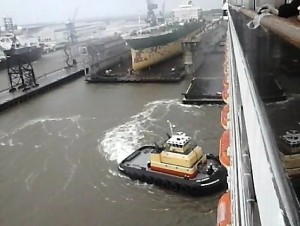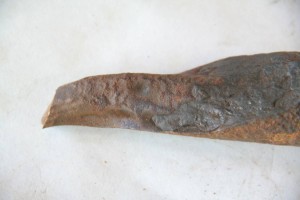
Image taken by Coast Guard investigators from the bulkhead of the Signal Ship Repair facility shortly after the collision, shows the positions of (from left to right) the Carnival Triumph, Noon Wednesday, and Wheeler.
On April 3, 2013 the cruise ship Carnival Triumph broke free from its moorings and drifted across the Mobile River, where it collided with a moored dredge. It also pinned a responding towing vessel between the ship and the dredge. The cruise ship was undergoing repairs at a shipyard in Mobile, Alabama, when the Port of Mobile experienced a period of high wind gusts. One shipyard employee died and another was injured in the incident.
This was the same ship that had an engine fire several days earlier which resulted in a loss of power and propulsion. The ship drifted four days about 150 miles off the coast of the Yucatan Peninsula before it could be towed into Mobile, Alabama for repairs. During this time, the ship was without air conditioning, and largely without lights, water, food, or working toilets creating a health hazard.
 U.S. Forensic engineer, Bill Janowsky, P.E. was hired to investigate the accident and determine the cause of the breakaway. Mr. Janowsky’s forensic engineering experience includes in-depth condition surveys and damage inspections of residential, commercial, and industrial buildings, docks and marine structures, bridges, and facility components. He has provided engineering consulting services for projects in the United States, United Kingdom, South America, and the Caribbean.[vimeo id=”63301652″ align=”right” mode=”normal” autoplay=”no”]
U.S. Forensic engineer, Bill Janowsky, P.E. was hired to investigate the accident and determine the cause of the breakaway. Mr. Janowsky’s forensic engineering experience includes in-depth condition surveys and damage inspections of residential, commercial, and industrial buildings, docks and marine structures, bridges, and facility components. He has provided engineering consulting services for projects in the United States, United Kingdom, South America, and the Caribbean.[vimeo id=”63301652″ align=”right” mode=”normal” autoplay=”no”]
Description of the Incident
The CARNIVAL TRIUMPH is a passenger cruise vessel of approximately 40,300 tons light displacement with a length overall (LOA) of 895 feet, beam of 116.5 feet, and maximum draft of 27.3 feet. The ship was constructed in 1999. On April 3, 2013, the CARNIVAL TRIUMPH was reportedly moored port side to along the north edge of Pier K at the BAE Systems Ship Repair facility in Mobile, Alabama with a total of 18 mooring lines deployed to 8 mooring bollards on the dock structure. A storm system affected the Mobile area at approximately 1:35 pm on April 3, 2013 and weather data indicated that maximum sustained winds of 52 mph and maximum gusts of 63 mph were recorded in the area at the time of the incident. During the storm, the stern of the CARNIVAL TRIUMPH moved away from the berth and 3 of the mooring bollards securing lines from the stern of the ship were pulled off of their mounts on Pier K. The stern of the CARNIVAL TRIUMPH reportedly drifted north and contacted nearby Pier J, causing the west end of Pier J to collapse and then the ship drifted to the east and out of the berth and into the Mobile River.
Analysis
Mr. Janowsky, P.E. reviewed documents and photographs of the accident, investigated the mooring hardware in question, and reviewed the dock and mooring hardware maintenance records.
Mooring Hardware
Inspection of the displaced mooring bollards following the breakaway revealed that the 4 steel anchor bolts used to secure each of the displaced bollards to the pier structure fractured when the bollards were pulled from their bases. Each of the steel anchor bolts was also found to be extensively corroded and exhibited a corrosion loss of 50 percent or more of the bolt diameter at the fracture locations near the bases of the bollard units. Metallurgical testing confirmed that the bolts had clearly lost material from corrosion prior to their failure and that the loss of material significantly diminished the load bearing capability of the bolts. Review of available maintenance records for the dock confirmed that there were on-going concerns regarding the condition and capacity of the mooring bollards dating to 2006 but that repairs to the bollards were performed on a reactive basis only after a problem or failure had already occurred and that there was no preventative maintenance program in effect for the mooring hardware prior to the incident in April of 2013.
- View of a mooring bollard on Pier K included in the 2010 Engineering report. Note the cracked and deteriorated concrete base and exposed anchor bolts
- View of the concrete base of a mooring bollard on Pier K reportedly taken shortly after the breakaway of the CARNIVAL TRIUMPH on April 3, 2013
- View of 1 of the anchor bolts reportedly recovered from a mooring bollard on Pier K. Note the heavy corrosion of the bolt and nut and the narrowing of the bolt from loss of material.
- View of 1 of the anchor bolts reportedly recovered from a mooring bollard on Pier K. Note the heavy corrosion of the bolt and nut and the narrowing of the bolt from loss of material.
- View of anchor bolts reportedly recovered from mooring bollards on Pier K. Note the narrowing of the bolts from heavy corrosion.
- View of anchor bolts reportedly recovered from mooring bollards on Pier K. Note the narrowing of the bolts from heavy corrosion.
- Close-up view of an anchor bolt reportedly recovered from a mooring bollard on Pier K. Note the extensive corrosion.
- Close-up view of an anchor bolt reportedly recovered from a mooring bollard on Pier K. Note that the bolt threads are barely discernable due to extensive corrosion.
Findings & Conclusions
The Mooring Bollards at the Pier K Facility were in Deteriorated Condition and had Reduced Capacity.
The mooring bollards at the Pier K facility were reportedly designed for an allowable working load of 50 tons (100,000 pounds) and were found to be generally satisfactory for supporting loads of that rated magnitude when the 4 anchor bolts were in as-new condition and the bollards were properly attached to the pier. However, some of the anchor bolts for the bollards that were displaced during the breakaway of the CARNIVAL TRIUMPH on April 3, 2013 exhibited notable corrosion and loss of diameter and cross sectional area. Analysis calculations for the bollards indicated that the corrosion of half of the bolt diameter would result in a loss of more than 75 percent of the cross-sectional area of the bolt and increase the individual tension and shear stresses within the bolts to 200 percent to 400 percent above the allowable design levels. The available evidence indicated that the anchor bolts securing the 4 bollards pulled free from Pier K on April 3, 2013 were corroded at the time of the breakaway which reduced the allowable capacity of the bollards well below the rated 50 ton loading.
The Shipyard Facility did not determine the Allowable Weather Conditions for the Mooring of the CARNIVAL TRIUMPH at Pier K prior to accepting the vessel for repairs.

In this image taken from the Carnival Triumph (starboard side, looking aft), the towing vessel Noon Wednesday is seen taking position on the hull. The dry-dock facility and the still-attached work barges are also visible in this image.
Passenger cruise ships typically have significantly larger superstructure positioned above the water line of the vessel than do cargo vessels and other trade ships of similar length. The larger superstructure of cruise ships results in a larger relative “sail area” and increases the effects of wind pressures imposed on the vessel. A vessel mooring analysis can be used to evaluate the suitability of a berth for a specific vessel by determining the loads imparted to the mooring hardware by the mooring lines in response to wind conditions, current velocity and direction, and the particular arrangement of the mooring lines. The calculations can be performed to ascertain the maximum weather conditions in which the vessel can remain moored at the berth without overloading the mooring hardware on the dock. Despite warnings regarding the condition and capacity of the mooring hardware at the berth, the fact that the CARNIVAL TRIUMPH was one of the largest vessels to utilize the facility, and that the ship would be without power while at the facility and would therefore have limited or no maneuverability to react to unusual situations, no formal mooring analysis was performed to determine the suitability of the berth for the intended vessel or to define the maximum allowable weather conditions for its mooring at that location.
U.S. Forensic Services
Visit our Marine Services and Expert Services pages for additional information.











